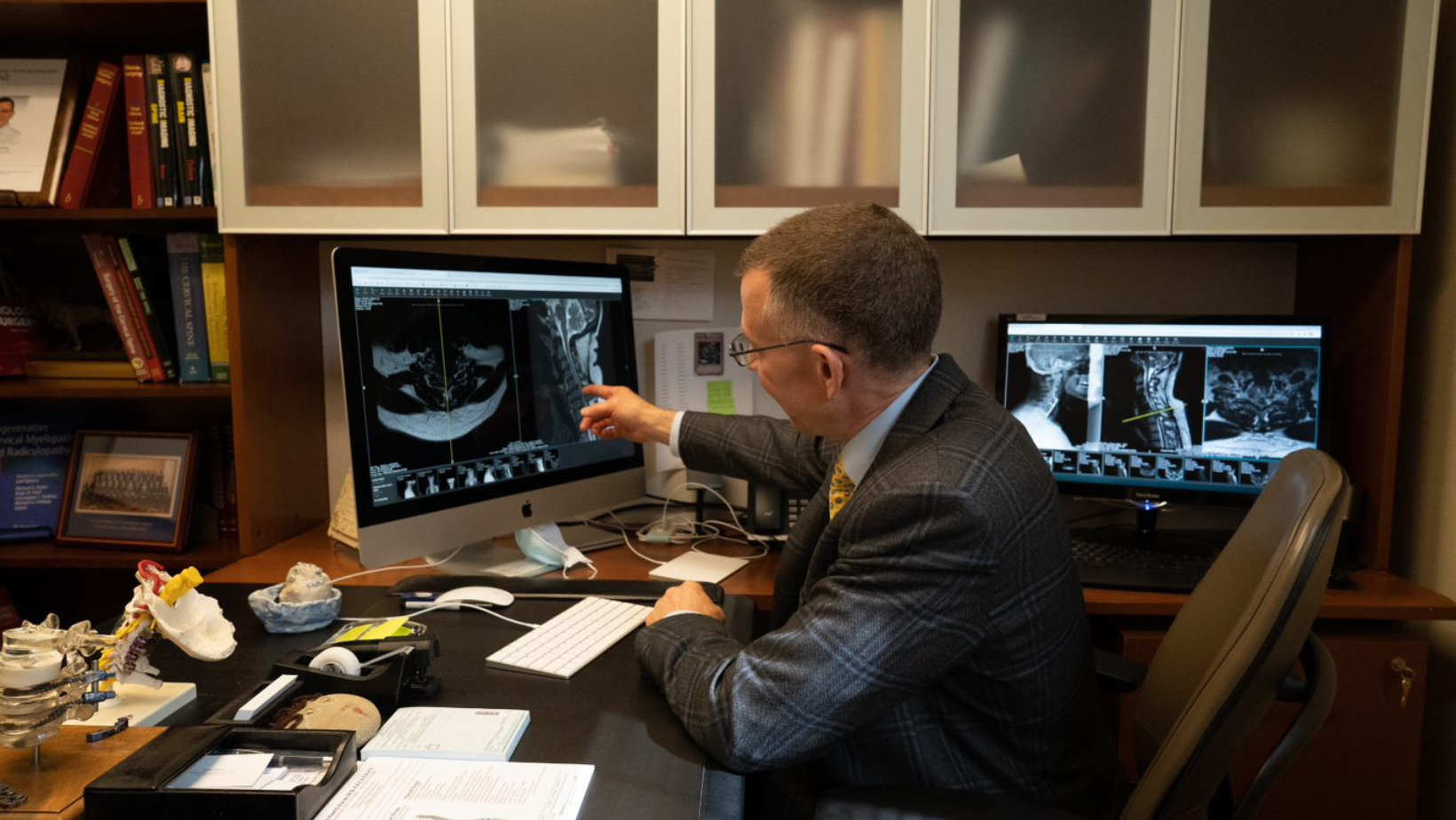TLIF: Lumbar Interbody Fusion Surgery
Transforaminal lumbar Interbody Fusion (TLIF) is a type of spinal fusion surgery used to treat degenerative spine disease and stabilize the lumbar spine. The goal of TLIF surgery is to fuse the vertebrae together, restore disc height, stabilize the spine, and alleviate pain.
In this article, we will explore the ins and outs of TLIF surgery, including its benefits, how the procedure is performed, recovery, and post-operative care.
What is TLIF surgery?
Transforaminal Lumbar Interbody Fusion (TLIF) is a surgical procedure commonly performed to treat various conditions affecting the lumbar spine.
It is primarily used to treat the following conditions:
- Degenerative Disc Disease
As a natural process of aging, the intervertebral discs degenerate, collapse, and can lead to pain since the disc is no longer able to withstand the normal stresses placed on the spine. A TLIF procedure, removes the worn out disc and restores support to the spine.
As a natural process of aging, the intervertebral discs degenerate, collapse, and can lead to pain since the disc is no longer able to withstand the normal stresses placed on the spine. A TLIF procedure, removes the worn out disc and restores support to the spine.
As a natural process of aging, the intervertebral discs degenerate, collapse, and can lead to pain since the disc is no longer able to withstand the normal stresses placed on the spine. A TLIF procedure, removes the worn out disc and restores support to the spine.
- Spondylolisthesis
Spondylolisthesis refers to the slippage of one vertebra over another due to degenerative changes. This shifting of the vertebrae can produce pain as a result of spinal instability. TLIF surgery stabilizes the affected vertebrae, realigns the spine, and alleviates associated symptoms.
- Spinal Stenosis
Spinal stenosis refers to the narrowing of the nerve channels within the spine. Degenerative changes cause bone spurs to form, discs to bulge, and ligaments to thicken. These changes compromise the pathways occupied by the nerves leading to irritation and sciatica. When stenosis is coupled with spinal instability, a TLIF procedure aims to decompress the spinal canal and provide stability to the affected area.
How is a TLIF surgery performed?
The patient is brought into the operating room and placed under general anesthesia. The patient is then positioned face down on the operating table, allowing the surgeon access to the lumbar spine.
The surgeon uses X-ray imaging to localize the affected area of the spine. An incision is made in the lower back and using specialized instruments, the surgeon carefully moves the muscles and soft tissues aside to expose the spinal bones (vertebrae).
If there is any nerve compression or spinal stenosis present, the surgeon may perform a laminectomy and/or foraminotomy. These procedures involve removing a portion of the lamina (bony arch) and degenerated joints, widening the nerve channels and relieve pressure on the nerves.
The surgeon removes the damaged or degenerated intervertebral disc located between the affected vertebrae. This helps relieve nerve compression and prepares the disc space for fusion.
To facilitate fusion, an interbody cage is inserted into the empty disc space between the vertebrae. This device is designed to maintain disc height and provide mechanical support. Grafting material is placed within and around the cage to promote fusion.
In addition, grafting material may be placed along the sides of the spine. The surgeon may take bone material from the patient’s own body (autograft), cadaveric bone graft (allograft), or synthetic material to enhance bone growth.
To provide additional stability, screws and rods are inserted into the vertebrae. These implants help hold the vertebrae in the desired position while the fusion heals.
The surgeon carefully repositions the muscles and soft tissues back into their original position. The incision is then closed using sutures or staples, and sterile dressings are applied.
TLIF is considered a major operation since it involves general anesthesia and placement of hardware such as cage, screws, and rods.
Advances in surgical technique however have led to less invasive methods to perform a TLIF, known as a minimally invasive TLIF.
What is a minimally invasive TLIF?
As opposed to open surgery, minimally invasive surgery is an approach to spinal fusion using smaller incisions. This causes less muscle injury, resulting in a less post-operative pain and faster recovery.
Patients may be able to resume normal activities sooner following a minimally invasive TLIF.
It's time to get back to doing what you love.
What are the risks TLIF Surgery?
As with any operation, TLIF surgery is associated with risks. In experienced hands however, the likelihood of these risks is very low. Here are some of the risks associated with TLIF surgery:
- Infection: A risk with any operation, with TLIF surgery an infection could involve the incision as well as spinal implants.
- Spinal fluid leak: The nerve sac is similar to a water balloon. If the sac is torn during removal of degenerative spine changes, the spinal fluid will leak out. This can compromise the soft tissue healing and lead to headaches.
- Nerve damage: Surrounding nerves may be affected during the procedure, potentially leading to numbness or weakness.
- Bleeding: Surgical procedures carry a risk of bleeding, which may require further intervention.
- Fusion failure: The ultimate goal of TLIF is to have the vertebrae heal together. In some cases, the fusion may not be successful, requiring additional surgery.
What are the benefits of TLIF Surgery?
- Pain relief: TLIF aims to alleviate pain due to mechanical compromise of the spine.
- Spinal stability: By fusing the vertebrae, TLIF restores the ability of the spine to withstand normal pressures placed during regular activities.
- Improved function: By improving pain due to spinal instability and nerve irritation, a TLIF procedure can lead to improved mobility, function, and quality of life.
Your doctor should discuss the procedure in detail and explain both the risks and benefits of having surgery.
Recovery from TLIF Surgery:
The recovery process following surgery typically involves the following:
- Hospital Stay: Patients may spend a few days in the hospital for post-operative care, pain management, and monitoring.
- Pain Management: Pain medications and other techniques are used to manage post-operative discomfort.
- Walking after surgery: Walking after surgery is strongly encouraged with most patients typically walking the day after surgery.
- Physical Therapy: In the weeks after surgery, physical therapy is a very important part of your recovery. You should focus on strengthening the core, improving flexibility, and restoring function.
- Gradual Resumption of Activities: Patients are advised to gradually increase their activity levels, following the guidance of their healthcare team.
- Follow-up Care: Regular follow-up appointments are scheduled to monitor your healing process. This typically will involve X-rays so that your doctor can assess the fusion success. During these visits your doctor can address any concerns may have.
TLIF surgery is a surgical procedure aimed at treating various conditions affecting the lumbar spine.
It is important to note that each patient’s situation is unique, and the specific details of a TLIF procedure may vary.
At Neurosurgeons of New Jersey, our surgeons are nationally recognized physicians in the evaluation and treatment of degenerative spine disease.
Contact our office today to schedule a consultation with one of our board-certified surgeons to see if you may be a candidate for TLIF surgery.

About Dr. Michael G. Kaiser
Dr. Michael G. Kaiser is a nationally recognized neurosurgeon in North Jersey and is a proud member of Neurosurgeons of New Jersey, practicing out of their Ridgewood office conveniently located on East Ridgewood Avenue. Dr. Kaiser specializes in complex and minimally invasive spine surgeries.






